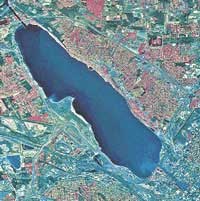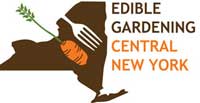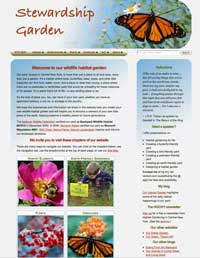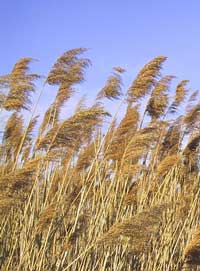A new kind of gardener
by Sara Stein
|
 | Purple milkweed
(Asclepias purpurea) |
|
We--you and I and everyone who has a yard of any size--own a big chunk of this country.
Suburban development has wrought habitat destruction on a grand scale. As these tracts expand, they increasingly squeeze the remaining natural ecosystems, fragment them, sever corridors by which plants and animals might refill the voids we have created.
To reverse this process--to reconnnect as many plant and animal species as we can to rebuild intelligent suburban ecosystems--requires a new kind of garden, new techniques of gardening, and, I emphasize, a new kind of gardener.
~ Sara Stein
Noah's Garden: Restoring the Ecology of Our Own Back Yards, p. 16, 1993
|
Onondaga Lakeshore Community Meeting
Tues. July 12, 6:30 at Solvay Library
|  | |
This is your chance to hear about plans for restoring Onondaga Lake and to share your ideas about the restoration. The discussion will pick up from the Geddes Lakeshore Enhancement project currently underway along the lakeshore.
The Tuesday July 12 meeting will focus on native plants. Don Leopold will be there as a resource.
Solvay Public Library is located at 615 Woods Road in Solvay. The meetings will take place downstairs in the Community Room. Your participation and voice is vital to this restoration effort.
|
| You're invited to participate in planning HGCNY |
 | Mountain laurel
(Kalmia latifolia)
|
| |
A small group of HGCNY officers and other people interested in helping plan HGCNY activities meets quarterly.
If you're interested in contributing in this way,
email me and I'll add you to the list and give you directions to our next meeting on Tuesday, June 28 at 7 pm.
|
| Preserving and Restoring Natural Landscapes Workshop |
 | | Cranberry bush viburnum (Viburnum trilobum) |
| |
Instructor: Jim Engel of White Oak Nursery
Date: Sat. July 9, 9-noon
Location: Linwood Gardens, 1912 York Road, Pavilion, NY
Deadline: July 6
Cost: $20, may pay upon arrival
To register, go to the Linwood Gardens website .
Jim will give a presentation on the identification of invasive plants, and strategies and methods of controlling invasive plants, as well as lead a discussion on the value of native versus non-native. There will be an opportunity for field identification.
|
| Interested in Edible Gardening? | 
|
If you'd like to get information on Edible Gardening CNY, just send an email to John to find out about edible gardening tours and programs.
|
|
Join HGCNY!
|  |
Becoming an official member of HGCNY is easy: just join Wild Ones! When you're a Wild Ones member, you're automatically an official member of HGCNY. |
|
Greetings!
 | | Baby wren |
Time for Show Me, Help Me Tours
Summer is the time for our garden tours, which Wild Ones traditionally calls Show Me, Help Me tours. These aren't the kind of tours where you just admire beautiful gardens. These are tours where you learn from what the host has done and perhaps offer suggestions for any landscaping dilemmas they may have. Some of our tours have expert commentators, too. Our programs during the year are always interesting and informative, but there's nothing like seeing the results in people's yards!
Here are the dates:
Sunday July 17 at 3 pm in Canandaigua. This is a tour of a large woodland setting with trails and benches. Jim Engel will co-guide the tour. RSVP to Linda.
Saturday July 23 at 9 am edible garden tour in Westvale; 10 am habitat garden tour. Tour either or both (directions). Sunday July 24 at 4 pm in Westvale (same tour as July 23).
Saturday July 30 at 2 pm in Fulton. This is a tour of a village lot backing up to a marsh. You can bring boots if you'd like to go into the marsh. Dan Carroll will co-guide the tour. RSVP to Linda, the host.
Saturday August 27 in Jamesville - Time and other details to be announced. RSVP to Randi, the host.
1) We will tour garden areas on a large rural property consisting of abandoned agricultural land and woods that have been harvested for timber over many years.
2) Potluck picnic
3) An opportunity for a longer walk into fields and woods. History buffs may also find things of interest. A small pond created two years ago for wildlife habitat can be seen.
 Meanwhile... Meanwhile...You can vicariously tour my own habitat garden by browsing through my website: OurHabitatGarden.org. You'll find lots of information about various creatures and how to provide habitat for them. Janet |
|
|
What is this caterpillar eating?
(Answer below.)
 | | Black swallowtail caterpillar |
|
 | |
Phragmites (Photo: michit - CC)
|
Weed volunteers needed ~ submitted by Fran Lawlor
Elbridge Swamp is the largest preserve of the Central New York Land Trust (formerly Save the County). Carpenters Brook flows through this high quality, federally protected wetland. There is a small infestation of introduced Common Reed (European phragmites) in the western portion of the preserve, just at the edge of the federally designated wetland. It has expanded in two main patches, approximately a quarter acre each and in a couple of smaller patches.
The Land Trust is interested in non-chemical control of the phragmites to protect the water quality of the wetland complex. It has been shown that an annual cutting at the end of July will suppress common reed. Complete eradication using mechanical control is unlikely. The Land Trust wants to reduce the density of the common reed to encourage native plant species and associated wildlife. This is a once-a-year work project, for many years.
Bird species in the area should include: winter wren, great crested flycatcher, wood pewee, wood thrush, veery, pileated woodpecker, Baltimore oriole, and red eyed vireo. There are many black ash and tulip poplar along with some nice wetland plants.
To volunteer
Bring hedge clipper or hand pruners and wear long pants, long sleeves, work gloves and a sun hat (to keep away deer flies).
The 2011 project date is Saturday, July 23, meeting at 8:00 a.m. at the preserve. Let's get done before it gets hot.
Contact Jeff Devine, Executive Director, Central New York Land Trust, (315) 575-8839 .
|
 | | Damselfly |
Zap the zappers
Take it from someone whose former neighbor operated one every night all summer--your neighbors' peaceful evenings can be ruined by hearing the constant zap, zap, zap.
They may not even protect you from mosquitoes As Science Daily reports: "They are a total waste of money. Bug zappers will not control mosquitoes or other biting insects such as horseflies, dogflies or deerflies," said Jonathan Day, associate professor of entomology ... They simply do not work as advertised. In fact, bug zappers actually make things worse by attracting more mosquitoes into your yard, and they end up killing thousands of beneficial insects that don't bother people."
They may spread harmful microorganisms Science Daily reports that researchers at Kansas State found bug zappers may shower microorganisms, including viruses, onto the surrounding area. Because of the airborne bacteria and virus-laden particles produced by the explosion of these electrocuted insects, they recommend they not be used in food handling areas, hospitals, or similar facilities. They kill billions of beneficial insects Studies reported by Colorado State Extension found that just 0.13% of the insects killed by one of these devices were female mosquitoes, and that these devices kill up to 350 billion beneficial insects in the U.S. every year. Can we really afford to kill that many beneficial insects? An entomologiest at Colorado State concluded,
"Bug-zappers are almost worthless for mosquito control. Despite their continued wide-spread sale and popularity, study after study shows they have no value for control of mosquitoes in ordinary outdoor settings. People receive just as many bites when a bug-zapper is used as when it is not." Better solutions might be a screen house or porch, applying an effective repellent such as DEET, or just remaining inside in the evenings when mosquitoes are active. |
 | | Bee on spiderwort |
Support BEE Highways
Deadline June 30
June 20 - June 26 is National Pollinator Week, and it is expected that the Highways BEE Act will be introduced in the U.S. House of Representatives. Please urge your legislator to pass this bill and sign-on to a group letter by Thursday June 30.
Transportation right-of-ways comprise more than 10 million acres of land in the U.S. alone. With the loss of natural areas to industrial agriculture and urbanization, roadsides are an increasingly important way to provide habitat. They can support native plants, provide refuge for wildlife, and connect fragmented habitat.
The Xerces Society has an excellent 8-page factsheet about managing roadsides for bees and butterflies. It can be downloaded from this webpage ...
|
|
Answer to question above
Unlike people's skin, the skin on caterpillars doesn't grow with them. When it's too tight, they shed the old skin. After their new skin dries, they turn around and eat the discarded skin!
Nature doesn't waste things.
|
|
|
|
|